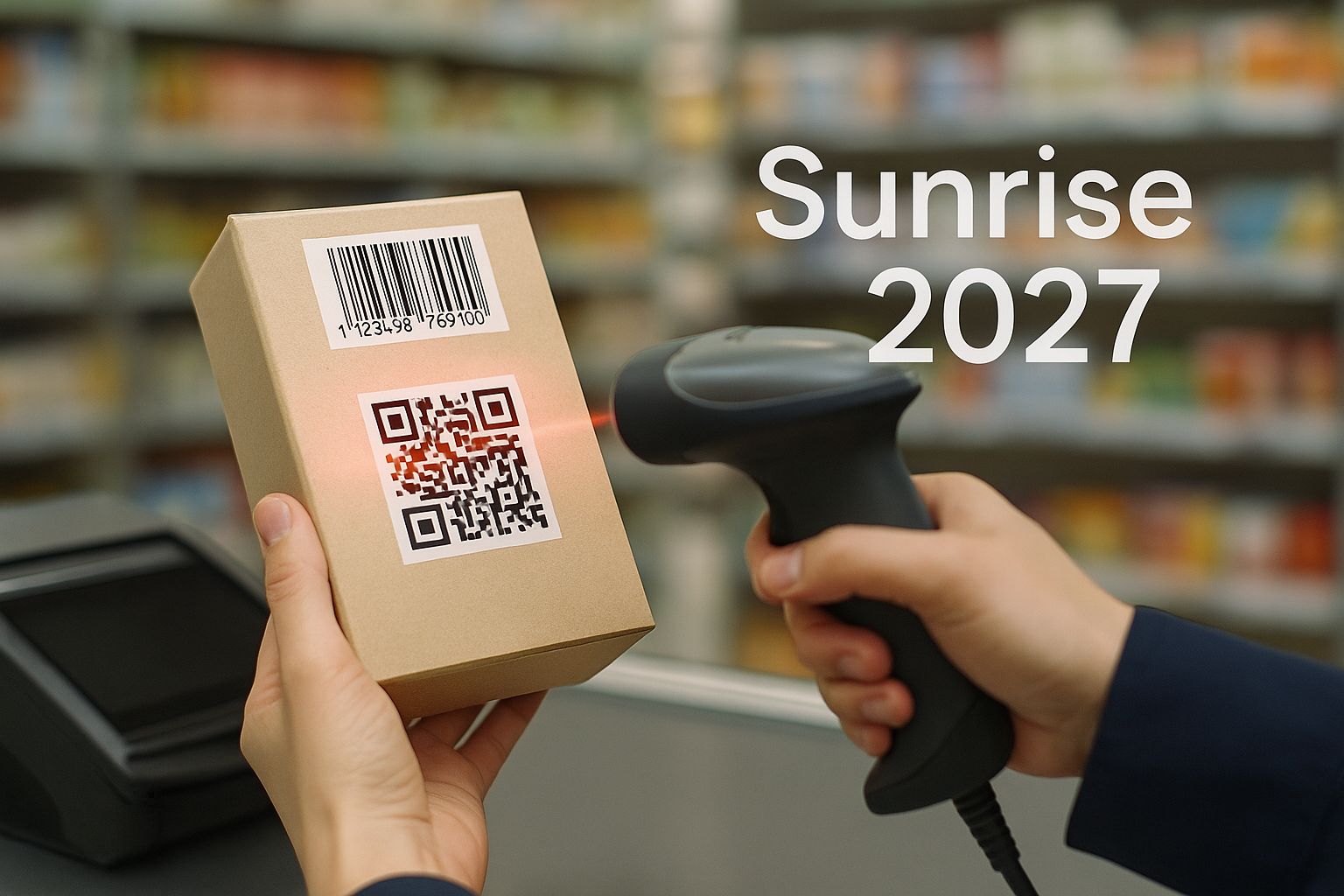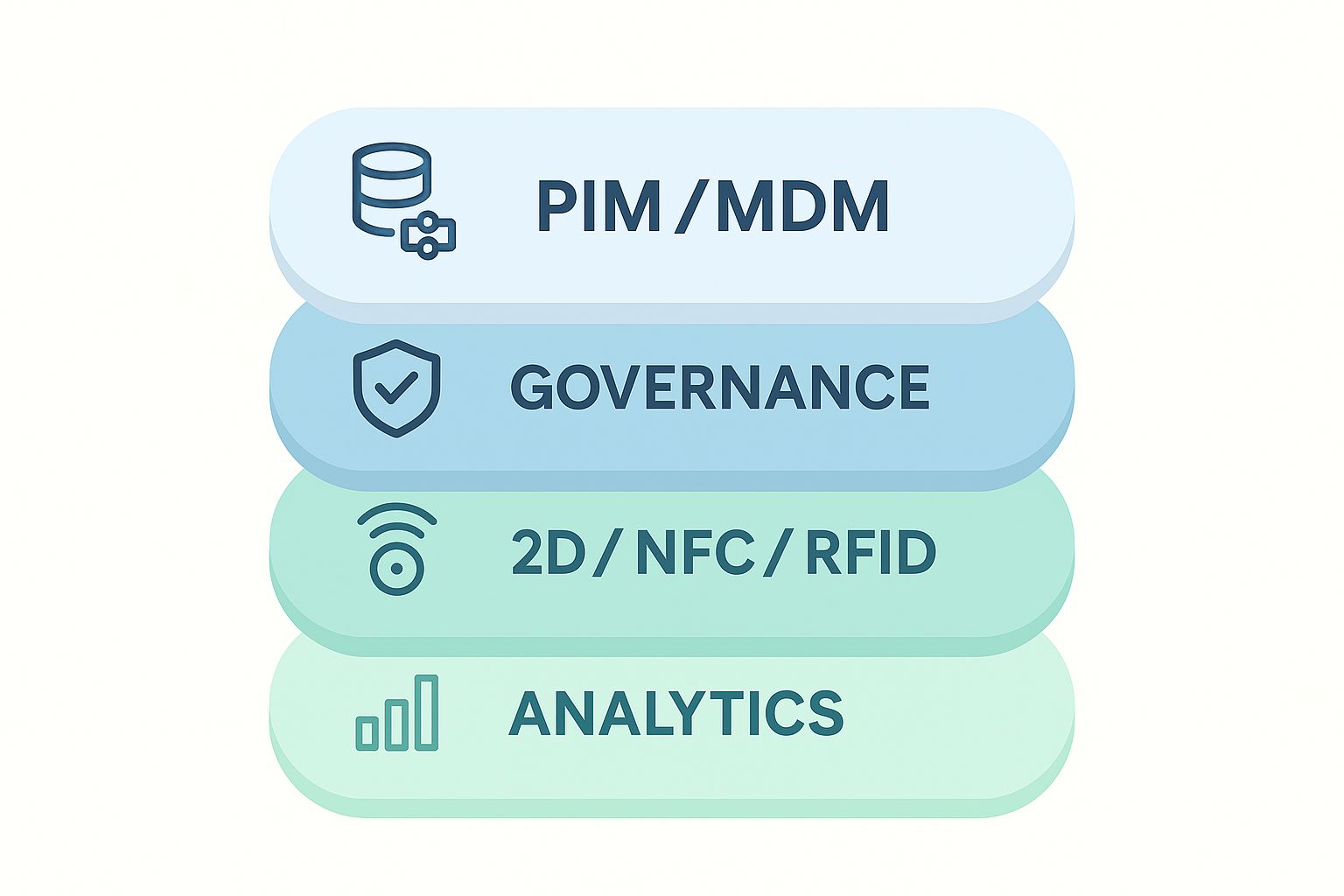
Retailers target broad 2D barcode acceptance by end of 2027.
By the end of 2027, retailers aim to accept 2D barcodes(QR/Data Matrix) at POS alongside legacy UPCs. These codes can carry GS1Digital Link² URLs to serve tailored content for shoppers, retailers, and regulators from a single scan. EU policy momentum around Digital Product Passports adds compliance pressure and opportunity.
- Sunrise 2027¹: global push for POS to read/process 2D codes by end of2027.
- GS1 Digital Link²: turns identifiers into a web URL that routes role-based content.
- DPP³ under ESPR: EU plans a digital product passport accessible via a data carrier such as a QR code.
- Industry alignment: leading brands/retailers publicly support the 2Dtransition timeline.
- Regulatory hygiene: QR use must avoid implying FDA⁴ endorsement when referencing programs.
For decades, 1D barcodes encoded a static product identifier. 2D codes carry more—batch/lot, expiry, and a web link—so a single scan can trigger recalls, show allergens, validate authenticity, or launch a post-purchase experience. GS1’s Sunrise 2027¹ initiative targets broad POS readiness, and guidance already exists for mixed environments where UPC and 2Dco-exist.
The strategic move is GS1 Digital Link². Instead of hard-coding a promotional short URL, you encode a standards-based link tied to your GTIN, with parameters for context (like batch or role). The same on-pack code can route a shopper to ingredients and usage, send a retailer to case/returns info, and provide a regulator with labeling proofs—without changing the code on the pack.

The Ecodesign for Sustainable Products Regulation (ESPR³) introduces the Digital Product Passport (DPP) concept—structured product information accessible to consumers, businesses, and authorities via a digital carrier such as a QR code. As DPP scopes phase in, connected packaging becomes a compliance enabler, not just a marketing tool. Global supply chains mean North American brands will feel this pull even if they don’t sell primarily in the EU.
Operationally, RFID continues its role in item-level accuracy and receiving, complementing 2D codes rather than replacing them.Several major retailers have expanded RFID use beyond apparel; the pattern is clear even as exact department lists evolve. Inventory and cycle-count gains from RFID pair well with QR-led consumer and compliance journeys—a practical two-tech stack many CPGs are piloting.
The part that fails most rollouts isn’t the symbol—it’s the data. If your link returns outdated ingredients, slow pages, or generic content, the experience (and trust) breaks. Build the foundation first: a structured product data model, clear governance⁷, and a resolver pattern you control.
Start by defining your URL and resolver⁷ pattern using GS1Digital Link² so you can change content without changing packaging. Map audiences (consumer/retailer/regulator) and the tasks each needs to complete—e.g., cooking instructions and allergens for consumers; returns and master case details for retail; label proofs for regulators. Keep the landing fast (LCP under ~2.5s), accessible, and localized.

Pilot with dual-marked packs (UPC + 2D) while POS upgrades roll out. Use a few SKUs that benefit from batch/lot info (e.g., perishable or recall-sensitive) to test serialization and recall drills. Measure: scan-through rates, completion of key tasks, and “data freshness” SLAs. Fold in RFID where inventory accuracy or receiving friction are pain points; don’t force it where it won’t pay off.
Most teams underestimate governance⁷. Treat the code like a living endpoint: version your content models, define who can publish which attributes, and set review cadences that align with regulatory updates. For regulatory graphics or program references, follow FDA⁴ guidance to avoid any implication of endorsement.
The move to 2D is less about the square code and more about what sits behind it: product truth, safety, service, and storytelling. Brands that fix data quality, get routing right, and respect the compliance landscape will turn packs into an always-on channel that helps shoppers, speeds ops, and satisfies regulators. For strategy or implementation support, contact CPGBrokers below.
1. GS1 Global – Sunrise 2027¹ Initiative Overview
2. GS1 – Digital Link Standard (Version 1.3)
3. European Commission – Ecodesign for Sustainable Products Regulation (ESPR)and Digital Product Passport Framework
4. U.S. Food & Drug Administration – Guidance on Use of QR Codes on Packaging
5. Deloitte – The Smart Packaging Revolution in FMCG
6. GS1 US – Transition to 2D Barcodes: Dual Marking, Testing, and Retail Readiness
7. GS1 Global – Governance Framework for Digital Link Resolvers and Data Ownership